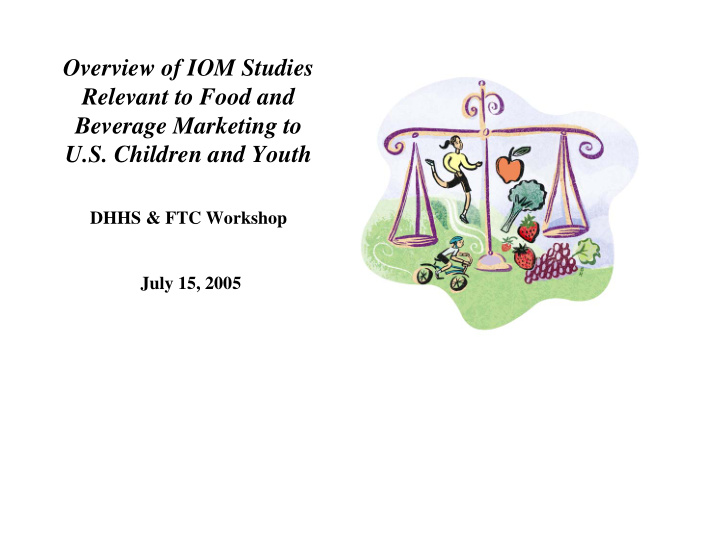



Overview of IOM Studies Relevant to Food and Beverage Marketing to U.S. Children and Youth DHHS & FTC Workshop Marketing, Self-Regulation, and Childhood Obesity July 15, 2005 Vivica Kraak, M.S., R.D. Institute of Medicine The National Academies Washington, DC
Discussion Points • IOM study background, process, key conclusions • Preventing Childhood Obesity: Health in the Balance • Order IOM report at www.nap.edu • Highlighted recommendations • Food, beverage, and restaurant industries • Advertising and marketing guidelines to children • Advertising guidelines in schools • Other relevant IOM studies in progress • Food Marketing and the Diets of Children and Youth • Progress in Preventing Childhood Obesity
IOM Study Background • Congressional request for IOM study (2002) • Sponsors were DHHS - CDC, NIH, ODPHP and RWJF • 24-month study duration • Task was to develop a prevention-focused action plan • 19-member multidisciplinary expert committee met at intervals to address scope of work and review the relevant scientific evidence to develop findings, conclusions, and recommendations. • Rigorous blinded peer-review process (21 reviewers) before public release of the final consensus report in September 2004.
Key Conclusions • Childhood obesity is a serious nationwide health problem with multi-factorial causes requiring a population-based prevention approach and a comprehensive response . • The goal is energy balance – healthful eating behaviors and regular physical activity to achieve a healthy weight while protecting health and normal growth and development. • Preventing childhood obesity is a collective responsibility —multiple sectors and stakeholders must be involved in societal changes at all levels.
What is Needed? • Leadership • Evaluation • Resources • Efforts at all levels • Change in societal norms Healthful Eating Obesity Prevalence Behaviors and Increasing Physical Activity are the Norm
Key Stakeholders Involved • Parents • Health Care • Families • Industry • Schools • Media • Communities • Government
Action Plan for Obesity Prevention • National public health priority • Healthy marketplace • Healthy media environment • Healthy communities • Healthy school environment • Healthy home environment
Marketplace Implications • Young consumers and their parents will need to change their food and beverage preferences and engage in regular physical activity and fewer sedentary pursuits to achieve energy balance. • Food, beverage, restaurant, entertainment, recreation, and leisure industries can be instrumental in changing consumer behaviors. • Many opportunities exist to influence consumers’ purchase decisions (e.g., develop, package, label, promote, distribute, and price).
Creating a Healthy Marketplace Recommendation 1 Industry should make obesity prevention in children and youth a priority by developing and promoting products, opportunities, and information that will encourage healthful eating behaviors and regular physical activity.
Food and Beverage Industry Product Development Food and beverage industries should develop product and packaging innovations that consider energy density, nutrient density, and standard serving sizes to help consumers make healthful choices.
Full Service & Quick Serve Restaurants Full service and fast food restaurants should expand healthier food options and provide calorie content and general nutrition information at point of purchase. * The committee encouraged enhancing or adapting the FGP or developing a new food guidance system and relevant educational materials that would convey how portion sizes should be distributed throughout the day for children of different age groups at restaurants.
Creating a Healthy Marketplace Recommendation 2 Industry should develop and strictly adhere to marketing and advertising guidelines that minimize the risk of obesity in children and youth.
Advertising and Marketing to Children • DHHS Secretary should convene a national conference to develop guidelines for the advertising and marketing of foods, beverages, and sedentary entertainment directed at children and youth with attention to product placement, promotion, and content. • Industry should implement the advertising and marketing guidelines. • The FTC should have the authority and resources to monitor compliance with the food and beverage and sedentary entertainment advertising practices.
Creating a Healthy School Environment Recommendation 3 Schools and school districts are urged to develop, implement, and enforce school policies to create schools that are advertising-free to the greatest extent possible.
IOM Study on Food Marketing and the Diets of Children and Youth Purpose • Review the effects of food and beverage marketing on the diets and health of children and youth in the United States, including the characteristics of effective marketing of foods to children and youth to promote healthy food choices. • Provide recommendations for public and private stakeholders to foster healthy food and beverage choices in children and youth. Product • Report to be released in November 2005
IOM Study on Progress in Preventing Childhood Obesity Purpose • Implementation of report recommendations • Develop an evaluation approach to assess progress in obesity prevention actions for various sectors. Process • Three regional symposia planned to focus on report recommendations for schools, communities and government, and industry. Product • Report to be released in 2006
Recommend
More recommend